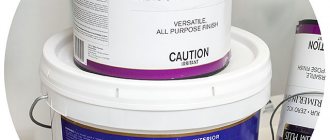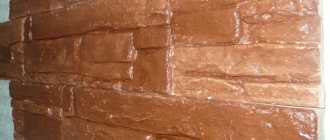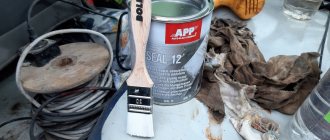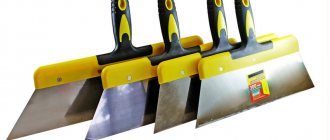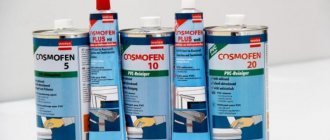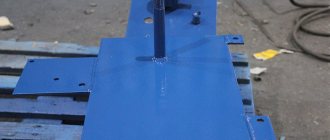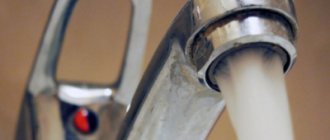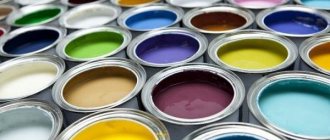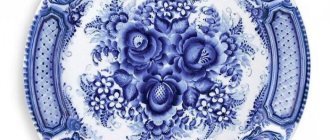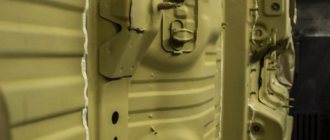Before use, metal structures must be protected from rust. Corrosion renders products unusable, destroying their structure. An anti-corrosion metal primer can be used as a protective layer. However, many craftsmen forget about this composition and apply paint immediately after cleaning the surface.
Anti-corrosion primer for metal
Why prime metal?
Protecting metal from corrosion is considered a priority in the manufacture and operation of metal workpieces. To increase the protective properties of the material, you need to apply an external protection agent to the part. A primer is a substance that penetrates deeply into the metal. The composition of purchased products includes inhibitors. They protect metal parts from corrosion.
In addition to the protective properties, the adhesion index improves - the paint adheres better to the surface being treated.
Applicability of materials
Different materials are used for different tasks and at different stages of work. A primary one-component primer is applied over bare metal to protect against corrosion. Such compositions dry for a day or more. They are used to a limited extent to protect car bodies. A simple and cheap alkyd primer GF 021 or body 992 is suitable for protecting metal in places not subject to mechanical and chemical influences.
Quick-drying one-component nitro primer cannot be used under acrylic paints and enamels with a metallic effect. But it is covered with alkyd or nitro paint. One-component acrylic primers are easy to work with, are quick-drying and compatible with a wide range of paint materials. Separating compounds form an intermediate layer between poorly compatible materials. They are also used when there is no certainty about compatibility.
Two-component compositions are used as base ones. A hardener is added to the base. They can be applied in a thicker layer to fill micro-irregularities and pores. Two-component compositions are capable of forming a soft or hard surface. The first is easier to grind, the second is stronger and of better quality.
Alcohol primers are convenient, dry quickly, but shrink. They are applicable for places where it is not critical. For plastic, materials with plasticizers are used.
Don't get too carried away with anti-rust products. If possible, the part should be cleaned before processing and a truly reliable passivating compound should be applied. All options intended for use against rust are a necessary measure. They should be combined with other processing tools. This could be GF 021 or body 992.
Main types of primers
You can find various anti-corrosion products on sale. The following types of commercial primers include:
- Passivating - the primer contains a large amount of chromium salts. They change the properties of the metal, and it stops interacting with the environment. It is important that the product contains as many chrome salts as possible. The protection of the material from corrosion depends on this. After application, the electrochemical properties of the metal surface are reduced.
- Converting primers for metal against rust. They are used in cases where it is necessary to quickly get rid of the effects of corrosion. The product converts the rust layer into a special compound that quickly deforms and comes off the metal surface. However, transformative primers are not protective agents. They must be used in conjunction with soils to create a protective layer.
- Phosphating agents are mixtures that are made on the basis of orthophosphoric acid. Additionally, a solvent is added to it. These products are suitable for processing homogeneous metals and alloys. Before application, you need to clean the surface from rust, dirt, and plaque. Increases adhesion index. Alkyd, polyurethane and ethanol paints work well on phosphating primers. Compared to other primers, products with phosphoric acid can withstand heating up to 220 degrees Celsius.
- Isolating products are based on neutral pigments. Thanks to them, a homogeneous film is formed on the metal that does not allow moisture particles to pass through. The key disadvantage of an insulating primer is that in the event of mechanical damage, moisture can get under the protective layer. In this case, corrosion will quickly spread over the surface of the material.
- Protective - compositions based on magnesium, aluminum and zinc powders. They stop the development of corrosion processes. It is important to choose mixtures with the largest amount of powder in the composition.
- Alkyd - are considered universal and combine the properties of passivating and insulating primers. They increase the adhesion rate, so the product can be coated with various paints and varnishes.
- Inhibiting - after applying the composition, a layer of enamel is formed on the metal.
Epoxy primers can be classified as a separate group. They are two-component compounds that are used to protect metal parts from aggressive environments.
Cans of primer
Characteristics of primer mixture for metal
The soil mixture is used both in large-scale production and at home. This is a solution used to combat corrosion phenomena and level out minor errors on the product. The film formed by the primer is resistant to temperature changes and high humidity.
There are several types of primers and each of them has its own consumption parameters per unit surface area.
This solution is always applied before applying the topcoat to ensure the result is of high quality. The advantages of treating the product with a primer mixture before painting:
- The finishing layer will adhere much more firmly and there will be no need to repaint the surface in the near future. In cases where the application of the primer mixture is neglected, the paint begins to peel, fall off and the process will quickly have to be repeated again.
- Corrosion protection prevents the formation of rusty areas on the surface.
- Significant savings in paint and varnish materials.
If, during repairs or final work, you apply a primer coat in a short period of extra time before painting, this will save both money and time. The next repair will need to be carried out much later.
Options for primer mixtures for metal
There are several common processing solutions that help facilitate final processing of the product and improve its performance:
- Alkyd primers are a very common option and are used most often. It consists of an alkyd composition in the base, with the use of various stabilizing substances and additives. The color of the coating is gray or brown. It is highly durable and dries quickly. Also contains: red lead, whitewash and other components. Compatible with almost any type of final coating.
- Products consisting mostly of orthophosphoric acid. It is used for surface types that are already slightly affected by corrosion. The solution helps restore the material and free it from rust. Phosphorus primers stop all oxidative processes and, as a result, strengthen the product. When using such products, it is imperative to remove rust from the surface being treated.
- Acrylic, water-dispersed options are used indoors, increase adhesion, and level the surface. This composition dries quickly and is suitable for coating iron surfaces and alloys of non-ferrous metals.
- Inhibiting primer. This composition does not form a general film over the product, but penetrates directly into the surface at the molecular level. As a result, some properties of the material change, it becomes denser and harder. When processed, they combine the properties of the primer mixture itself and the enameled surface. Every day such coatings for various metal surfaces are becoming more and more in demand.
- Protective. This product contains magnesium and zinc. The higher the content of powders in this mixture, the higher quality it is considered. Particularly popular are compounds that contain red lead. Thanks to these components, the metal surface hardens and even the smallest scratches do not form on it. Ideal for those structures and products that have frequent contact with fresh and sea water.
- Converter. A variant of a mixture that is mixed with a corrosive coating. As a result, the structure of these stains becomes more porous and can be easily removed from the metal surface. Therefore, at the beginning of work on such material, it is not necessary to clean off rusty areas from the surface. Therefore, transformative compounds are an option for the lazy.
- Insulating mixtures. In this version, the base is a neutral pigment. But the primer itself has a short shelf life.
Each subtype of soil mixture has its own characteristics, which should be clarified when selecting. It must be suitable for the type of metal that is supposed to be processed.
The optimal characteristics for a standard metal primer are:
- semi-gloss or matte type of film;
- the period during which the mixture dries should be no more than 12 hours;
- elasticity parameters of the finished film without taking into account bending - no more than 1;
- conditional viscosity parameters more than 45.
This primer will significantly increase the service life of the metal surface and paintwork.
How to choose the right soil?
When choosing a primer mixture, you need to take into account a number of criteria, thanks to which you can eliminate errors and choose a high-quality composition:
- It is necessary to take into account the type of material being processed.
- Take into account the specific conditions for applying the composition to the surface. These include humidity levels and temperature conditions.
- Tools used to carry out work. Spray, roller, brush.
The approximate primer consumption per square meter is indicated on purchased packaging.
Preparation for priming
After choosing a tool, you need to prepare the metal surface. To do this you need to perform a number of actions:
- Clean the workpiece from dirt, rust, old decorative coating, and plaque. To do this, use a metal brush, grinder, sandpaper. For industrial purposes, a sandblasting machine is used to clean metal structures.
- Scale can be removed from a metal surface using heat treatment. A gas or oxygen burner is used for this.
- After removing the layer of rust, dirt, plaque, the metal product is degreased using a solvent.
The last stage of preparing the working surface is drying. To do this, use an air flow, which is supplied using a special gun and compressor. Additionally, you can use a hair dryer.
Cleaning metal surfaces
Priming technique
Priming of metal surfaces takes place with certain features. First of all, you need to read the instructions indicated on the packaging of the purchased composition. If the product is two-component, it should be mixed in certain proportions. The optimal amount of diluent added to the composition is 20%.
After preparing and degreasing the surface, you can begin the main work. The primer can be applied with a brush, roller, or spray. The disadvantages of the first two methods are that when working with hand tools, smudges, splashes, and untreated areas may remain. When working with a sprayer, a uniform layer of protective coating is obtained. Experienced craftsmen recommend applying 1 layer of primer, waiting until it dries, then applying a second layer. Painting of metal should begin immediately after priming. If you delay, the surface will become covered with a layer of dust, which will disrupt adhesion.
Metal structures are exposed to environmental factors. Prolonged contact of metal with moisture can lead to the formation of rust. To protect the metal from rust, you need to treat the workpiece with special solutions. These include primers and paints and varnishes. With their help, you can achieve improved corrosion resistance and adhesion.
Anti-corrosion coating as a method of protection against corrosion.
The most popular method of corrosion protection is the use of paints and varnishes. The paint and varnish coating creates a protective anti-corrosion layer that prevents the influence of an aggressive environment on a metal structure or product.
With the correct selection of coatings and application method, fairly reliable protection of metal structures from corrosion in the atmosphere and a number of corrosive environments is provided (for example, painting of river and sea vessels, water tanks, oil tanks, industrial metal structures and bridges, etc.)
The main advantages of anti-corrosion coatings are:
- comparative cheapness;
- relative ease of application;
- ease of restoration of damaged coating;
- compatibility with other methods of protection, such as tread protection, phosphate and oxide coatings;
- the possibility of obtaining coatings of various colors, which, along with protective properties, also have decorative properties.
The main disadvantage of paint and varnish coatings in the fight against corrosion is their relatively low mechanical strength, resistance in an aqueous environment, and low heat resistance.
The maximum operating temperature of the coating is 150 – 200ºС (with the exception of coatings based on organosilicon paints and varnishes
).
The effectiveness of using paint and varnish coatings is advisable provided that the service life is no more than 10 years. If it is necessary to increase the service life of a metal product, then combined coatings should be used. For example, galvanization plus paint and varnish coating. This coating allows you to increase the protection period to 30 years.
The protective effect of a paint and varnish coating is to create a continuous film on the surface of a metal product, which prevents aggressive environmental influences and protects the metal from destruction. This is primarily achieved by increasing the length of the path of corrosive agents to the metal substrate - i.e. reducing the permeability of the paint coating.
The shape of the pigment particles in the paintwork material has a significant influence on the permeability of the coating film. The greatest barrier effect is achieved by coatings containing flake-shaped pigment particles (mica, aluminum powder, iron mica, some brands of microtalc, etc.). These particles are located in the coating parallel to the substrate, covering it like a tile and making it difficult for corrosive agents to access.

